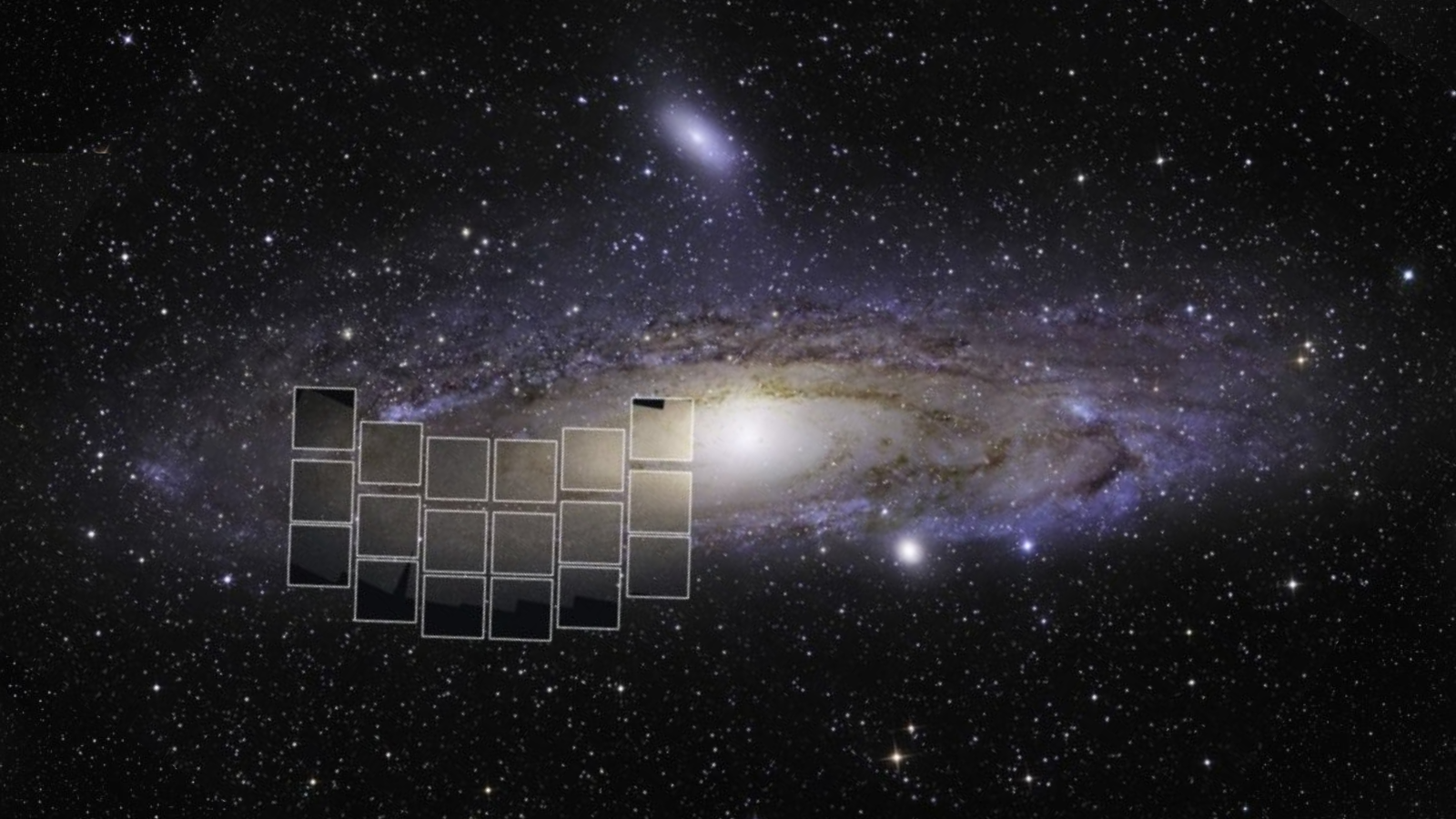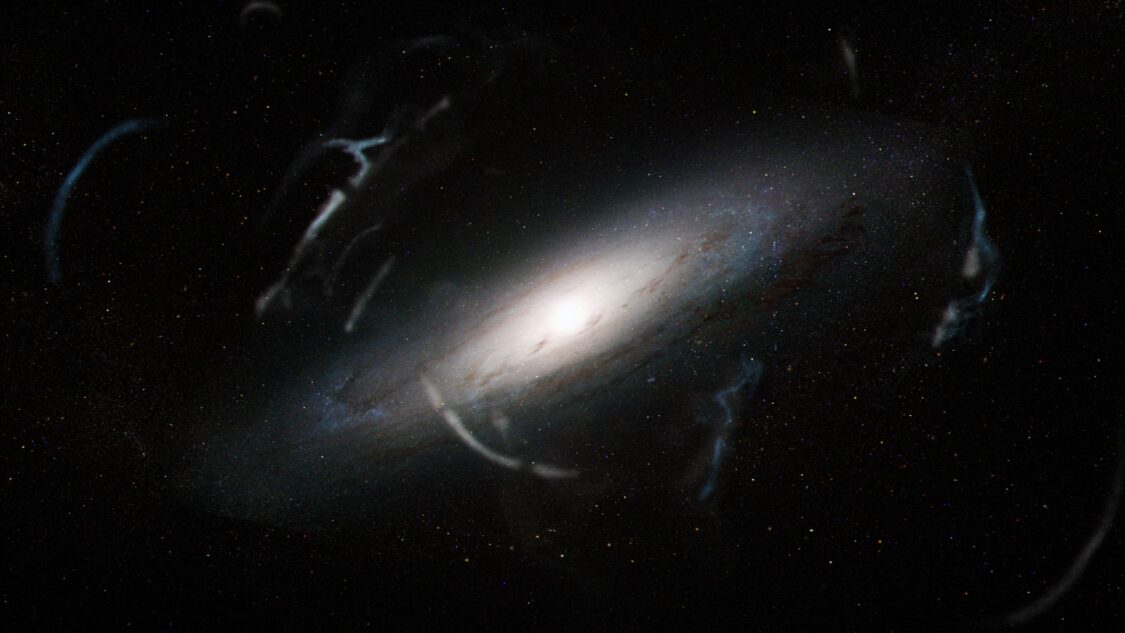
Images created by NASA's forthcoming Nancy Grace Roman Space Telescope may allow scientists to search for dark matter between stars.
An international team of researchers believes that gaps present in strings of stars hanging from tightly packed balls of ancient stellar bodies, called globular clusters, could be influenced by dark matter clumps.
Thus far, astronomers have only been able to study these dangling stellar streams within the Milky Way, meaning our understanding of them is limited. Roman, set to launch in 2027, should be sensitive enough to see these structures in our neighboring galaxy Andromeda — and with such detail it'd be possible to see disruptions caused by dark matter, giving astronomers clues about this elusive substance.
"There are stellar streams in our own galaxy, where we see gaps that might be due to dark matter," Tjitske Starkenburg, team member and a scientist at Northwestern University, said in a statement. "But these gaps also can be formed by other means."
Related: 'Dark force' theory could solve 2 open cosmic mysteries
The team makes the case that, as Roman observes gaps in galaxies other than the Milky Way, it will provide scientists with a better picture of these gaps as a whole. This could ultimately help determine the existence and properties of dark matter clumps.
Reading between the lines (or the stars, rather)
Dark matter is troubling for scientists because, despite the fact it accounts for an estimated 85% of the matter in the universe, they have very little idea what it is.
Dark matter doesn't interact with light, which means it's effectively invisible to our eyes and can't be made up of atoms comprised of the electrons, protons and neutrons that make up "everyday" matter we're used to. Think, stars, planets, flowers, books. Everything we see with the unaided eye — including our bodies — is made up of such "normal" matter.
Dark matter does interact with gravity, however, and that means the only way that scientists can infer its presence is by looking at how its influence on gravity subsequently influences all that everyday matter and light.
The fact that dark matter interacts gravitationally is actually fortunate for the evolution of the universe. Some galaxies, for instance, are rotating so fast that the gravity of their visible matter — stars, gas, dust and planets — wouldn't be sufficient to prevent them from pretty much flying apart.
"We see dark matter's effect on galaxies," Christian Aganze, team member and a postdoctoral fellow at Stanford University, said in the statement. "For example, when we model how galaxies rotate, we need extra mass to explain their rotation. Dark matter may provide that missing mass."

Clues about dark matter may well be dangling from globular clusters, which often contain millions of stars, along with loose stellar streams. That is because scientists think dark matter can "punch holes" in these stellar streams, creating gaps that can be used to assess the nature of this mysterious form of matter.
"The reason these streams are most interesting to see the effects of these dark matter clumps is twofold," Starkenburg said. "First, these streams 'live' in the extreme outer regions of a galaxy, where there otherwise is very little structure.
"And second, these streams are intrinsically very thin because they formed from dense clusters of stars, which means that you can see gaps or any disturbance much more easily.”
This isn't a new idea, but it is one that hasn't been fully exploited to get to the bottom of the dark matter problem. Current space telescopes and ground-based instruments are limited to searching for dark-matter-punched holes in a small number of stellar streams hanging from globular clusters within the Milky Way.
From its position around 1 million miles (1.6 million kilometers) from Earth, Roman will be able to investigate such features in neighboring galaxies, particularly Andromeda, for the first time. Its wide-field instrument will produce images 200 times the size of those created by the Hubble Space Telescope.
To test this, this team simulated streams of stars and allowed them to interact with dark matter clumps, generating gaps as predicted. The scientists then created mock Roman observations of these dark matter-punched spaces in stellar streams. They concluded that Roman will indeed be capable of detecting these gaps when it opens its eyes to the cosmos at last.
Roman will shed more light on dark matter
The study of stellar streams hanging from globular clusters won't be the only dark matter hunt that Roman engages in as it studies the universe.
Scientists think that most, if not all, galaxies are enveloped in haloes of this mysterious matter. And these haloes are believed to extend far beyond the galaxies' visible matter contents. The latter will also be studied by the space telescope, named after NASA's first Chief of Astronomy Nancy Grace Roman, who is affectionately known as the "mother of Hubble."
Not only will Roman be used to investigate the dark matter halo around Andromeda, but it will also investigate the possible existence of smaller "sub-haloes" of dark matter around the nearby galaxy.
"We expect smaller dark matter sub-halos to interact with globular cluster streams," Starkenburg said. "If these sub-halos are present in other galaxies, we predict that we will see gaps in globular cluster streams that are likely caused by these sub-halos.
"That will give us new information about dark matter, including which kinds of dark matter halos are present and what their masses are."
As well as being involved with this study, Starkenburg is already helping to lay the groundwork for Roman's dark matter detective work with the aid of funding through NASA's Nancy Grace Roman Space Telescope Research and Support Participation Opportunities program.
“That team plans to model how globular clusters form into stellar streams by developing a much more detailed theoretical framework,” she said. “We will go on to predict the origins of stream-forming globular clusters and whether these streams will be observable with Roman.”
The team's research is detailed in a preprint paper featured on the paper repository arXiv and has been accepted for publication in The Astrophysical Journal.







